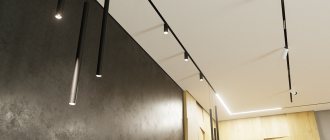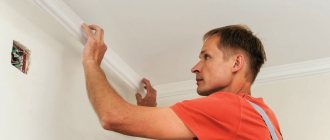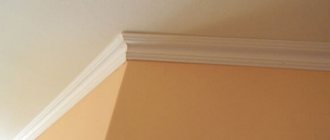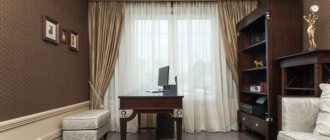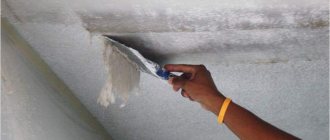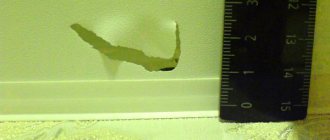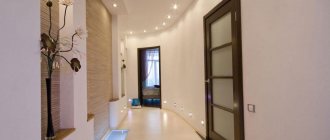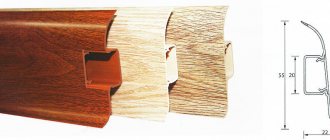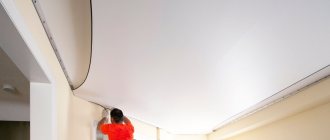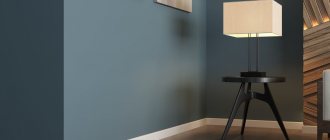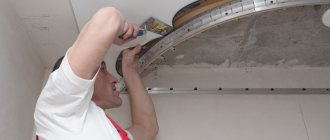Is it necessary?
The answer to the question of whether a plinth is needed depends on the type of ceiling installed.
If we are talking about PVC film, then yes, a baguette is necessary. Because such fabrics are stretched in three ways: harpoon, wedge and glazing bead.
In all cases, a gap of about 0.5 cm is formed along the perimeter between the wall and the film. This looks unaesthetic, so it is covered with a plinth or a special decorative insert.
If we are talking about fabric stretch ceilings, then they are inserted into a special clothespin profile. In this case, there are no gaps left, and there is no urgent need for a plinth. If desired, you can not install it.
Installation
To perform the installation you will need a knife, a construction tape, a miter box, a spatula, a cord, and a pencil. Before installation, the profile is painted with special acrylic compounds, which are quick-drying and non-hazardous. To protect the wall from unexpected contamination, it can be covered with polyethylene or construction tape. Ceiling borders can only be attached to walls or frames. Sometimes liquid nails are used for this; they are suitable for any baseboards.
How to glue skirting boards to a PVC stretch ceiling? Process:
- Cut a piece of the plank to the desired size and form an angle. Do not cut the protrusion with an eye - this will create huge gaps at the joints, so always use a miter box.
- The affected area is cleaned, marked and primed.
- The adhesive composition is applied to the back side of the decorative strip. Carefully read the instructions for the selected adhesive. Some compounds need to be allowed to dry for a few minutes, others can be pressed on straight away.
- The plinth is glued from one corner by lightly pressing the edges against the walls. If curtains are placed between the wall and the ceiling, then in some areas you need to attach the slats at a short distance from the wall.
- The joint gaps are masked with putty.
- Excess glue squeezed out from vertical joints is immediately removed with a clean cloth.
- After which the backlight is installed, if necessary.
A stressed ceiling sheet is often subject to natural deformation, since the ambient temperature is not always constant. Never glue ceiling decor to the stretch fabric. Attaching to the fabric itself can disrupt the shape of the fabric and often leads to the appearance of glue droplets.
How is it different from usual?
You cannot glue anything to a thin fabric. Therefore, the plinth for a stretch ceiling should be quite light, because it will only be attached to the wall.
It is also worth paying attention to the shape. It should be such that the wider part is adjacent to the wall. This way the fixation will be more reliable.
One more nuance needs to be taken into account; many people confuse a regular baseboard with a camouflage insert. And these are two completely different things.
Regular moldings can be used with any ceiling, and inserts can only be used with a tension ceiling. They have a special T-shape to be inserted into the profile groove on which the blade is held.
PVC ceiling curbs
PVC trim strips are available in a variety of beautiful colors and designs and are inexpensive. Strong and durable, they are not flammable, are not affected by putrefactive bacteria, and can imitate stone, plaster, wood or other materials. Experts suggest using this option when decorating a ceiling with a square or rectangular configuration, which is due to low flexibility.
Pros:
- lungs;
- durable;
- abundance of colors and textures;
- low cost.
Minuses:
- turns yellow quickly;
- does not bend well;
- For cutting you need to use a hacksaw.
Some variations of plastic fillets have detachable connections, this allows them to be fixed in a hidden way using self-tapping screws. If significant defects occur, it is possible to replace one of the profiles with a new one.
Skirting or insert?
Both options are acceptable. It cannot be said that a plinth is better than an insert or vice versa. You need to proceed from the specific situation and the overall interior design.
So, for multi-level ceilings it is better to use an insert. It will make the finished composition more neat and concise.
If the walls are not perfectly smooth, you should opt for a plinth. It will smooth out the contrast between the absolutely smooth canvas and crooked supports.
The more unevenness there is on the walls, the wider the baguette you need to choose.
In this case, the plinth can be used usefully. For example, hide a curtain rod behind it, as shown in the photo below.
In some cases, both edging options are used. Most often, this solution is used when organizing lighting: the insert is placed around the perimeter of the canvas, and the plinth is lowered 5–10 cm below - then an LED strip is laid on it.
Each option has approximately an equal number of advantages and disadvantages.
| Skirting | Insert | ||
| pros | Minuses | pros | Minuses |
| Helps organize lighting | The panel may be damaged during installation. | Quick and easy installation | Occasionally falls out of the groove |
| Smoothes out uneven walls | Beautiful baguette models are more expensive than inserts | Emphasizes the curvature of walls | Doesn't always match the ceiling |
| Wide selection of materials and designs | Not suitable for multi-level ceilings | If necessary, it can be easily replaced with a new one | May change color over time |
| Self-installation is not always possible | Has a standard design | ||
| It is often impossible (or very difficult) to change | |||
Kinds
In addition to this appearance, moldings are divided by materials and sizes (width).
Material
Modern industry offers a variety of skirting board options. But not all varieties are suitable for NP.
First of all, you need to abandon massive moldings made of heavy materials (for example, plaster). You can replace voluminous stucco with lighter analogues. The appearance will remain virtually unchanged, but the load on the wall will not be so great.
It is also worth paying attention to the shape of the room. For curvilinearities, it is better to choose more flexible materials. And with an abundance of corners in the room, you should opt for materials that are easy to cut and do not crumble.
Below is a list of the most suitable options, indicating the advantages and disadvantages of each variety.
Polyurethane
Polyurethane is one of the most popular materials for fillets. The assortment of construction stores will allow you to choose a model for any interior.
As for the color palette, everything is simple. This polymer can be easily painted in any shade. If desired, it can be given various effects: antique, etc.
Polyurethane skirting boards can be divided into three types.
With imitation stucco.
Such cornices have a rich finish and successfully replace heavy plaster. In addition, there are other decorative elements with the same pattern: columns, fireplace decorations, etc. This allows you to decorate the room in a single style.
Flexible baseboard.
It cannot be said that this type of polyurethane is frankly soft, but it bends easily, allowing you to create rounded shapes and various curves. A round or slanting ceiling will not be a problem for such a fillet.
With a niche for lighting.
Almost all types of polyurethane skirting boards have a special groove for wires. But often it is hidden in the center of the cornice. But there is a separate type of moldings with an open niche on top. It perfectly includes a diode strip when organizing the backlight.
The main disadvantage of polyurethane is its price. The cost per linear meter can reach several thousand.
But these costs are justified. The polymer is incredibly durable. It can easily withstand temperature changes, which allows it to be used not only in residential apartments, but also in unheated cottages.
Another disadvantage of polyurethane: it can shrink. One-time, insignificant, but in some cases this is enough for the seams to come apart and unsightly gaps remain between them.
Wood
Once upon a time this material was the only possible one, but now wood is used extremely rarely. Yes, this material is more natural, but its price and difficulties in care and installation scare off ordinary people.
Rubber
Customers often puzzle workers at hardware stores by asking them for rubber skirting boards for suspended ceilings. There are no such elements. An insert is made from rubber, which ordinary people confuse with a classic fillet.
This also includes frequent questions on forums, such as: how to insert a skirting board into a suspended ceiling, etc. You can only fill the insert; the cornices are glued.
PVC
Initially, polyvinyl chloride baguettes were created specifically for PVC panels. And the first models of such skirting boards had a special groove into which these same panels were inserted.
But the material turned out to be so successful that they first began to insert MDF panels into the groove, and then the range was expanded and began to be used for all types of ceilings.
The demand for PVC is due to one thing - simple installation. When installing it yourself, the main difficulties are caused by gluing the corners (especially on wide baseboards). PVC fillets eliminate this problem, as they are assembled like a construction set. True, not everyone likes the look of the connecting elements.
Duropolymer
Duropolymer is a Belgian material based on polystyrene foam.
The list of advantages includes significant strength, almost anti-vandalism.
The disadvantages of duropolymer ceiling plinths include a relatively small selection of models. Patterned stucco and graceful lines are not to be found here.
In addition, duropolymer cornices are quite massive. This polymer is of course lighter than gypsum, but bulk molding will weigh quite a bit. Such elements often require fixing not only to the wall, but also to the ceiling. But in the case of a stretched fabric, this is impossible.
Otherwise, this polymer is somewhat reminiscent of polyurethane. It can also be painted, it can be used to organize lighting, but it is not so flexible. But it costs about thirty percent less.
Styrofoam
Foam moldings are the lightest and most inexpensive. But this material cannot be considered durable and reliable.
The choice of foam models is very large, but due to the structure of the material, joints and corners may not be very neat.
It is better not to leave foam baseboards in their original white color. Over time, this material turns yellow.
Size
The length of the baguette does not really matter. All products are perfectly cut to the desired size of the room. You need to pay attention to the width.
Narrow
A narrow plinth (from 1 to 5 cm) is used in three cases:
- for improving multi-level ceilings;
- with perfectly smooth walls;
- if the room has a low ceiling height (in Khrushchev buildings, etc.).
But there are options when the room has a small height, but the walls are uneven. In this case, a wide baguette will look tacky, and a narrow one will emphasize unevenness.
To hide defects, you can use a little trick - hide the corners of the room. It is at the joints that the curvature is most noticeable.
By hiding corners behind curtains, tall cabinets, or voluminous plants, you can visually “align the walls.”
In tandem with this decor, you can use a narrow molding.
Average
Medium width skirting boards are the most versatile. Each manufacturer has similar models, which allows you to choose an interesting option for any room. 5–15 cm - this is the width range that is best suited for rooms with a height of 2.5–3 m.
Fillets for hidden lighting are available in this size, which allows you to decorate ceilings without “stealing” precious centimeters.
Wide
Moldings 16–35 cm wide are suitable only for large rooms with a ceiling height of at least 3 m. For such large structures, you need to pay attention to the weight of the products. Due to the impossibility of attaching to the canvas, not all models can be used.
Rating of mid-price segment products
Ceiling plinth 121*48*2000 mm (213065)
Expanded polystyrene is used in the manufacture of products. A white model is available, which allows you to give it the desired color using water-based paint. It does not shrink over time and withstands high humidity. Separates the suspended ceiling from the wall, giving a complete look to the structure. Used as additional lighting when installing LED strip. The part of contact with the wall is wide, which allows it to be fixed qualitatively using liquid nails or polymer glue. There is no need to glue it to the ceiling. The joints are strong. Over time, the seams on them do not come apart. Dimensions – 121*48*200 mm. Manufacturing method - injection.
The purchase price is 260 rubles per 1 meter.
plinth Ceiling plinth 121*48*2000 mm (213065)
Advantages:
- ease of installation;
- suitable for regular and suspended ceilings;
- value for money;
- practicality;
- strength;
- light weight;
- functionality;
- wear resistance;
- reliability;
- long service life.
Flaws:
- not identified.
Ceiling plinth 68*36*2000 mm (207503)
The product is standard white. Using water-based paint, you can give the molding any shade. In production, polystyrene foam/expanded polystyrene is used. Does not shrink and does not absorb liquid. Can be an additional light source when arranging an LED strip. Suitable for suspended ceilings. The wide part allows you to firmly attach the cornice to the wall. The seams are strong and do not separate at the joints. For installation, you need to purchase polymer-based glue or liquid nails.
The sellers are asking 150 rubles for the products.
plinth Ceiling plinth 68*36*2000 mm (207503)
Advantages:
- manufacturing method - injection;
- versatility;
- ease of installation;
- functionality;
- resistance to high humidity;
- reliability;
- can be used as a backlight;
- durability;
- safety.
Flaws:
- are not seen.
Ceiling plinth 53*28*2000 (06001/KD)
The Konigdeko series belongs to the category of new products. Products of improved quality are designed to eliminate shortcomings associated with the design of suspended ceilings. Allows you to make the appearance of the room aesthetic and complete. The density indicator reaches 40 – 45 kg/cub.m. Each element is supplied for sale in individual shrink film. Suitable for decorating various rooms. They acquire a suitable shade thanks to the use of water-based paint. In addition to the cornice, you can purchase the corner structure 01KDU. Product dimensions – 53*28*2000 mm.
The average cost is 220 rubles.
plinth Ceiling plinth 53*28*2000 (06001/KD)
Advantages:
- functionality;
- wear resistance;
- practicality;
- presence of backlight;
- long service life;
- reliability;
- produced by injection;
- does not require careful care;
- possibility of selection of any color;
- retains its original properties for a long time.
Flaws:
- not identified.
Ceiling plinth 94*47*2000 (210563)
The product is suitable for edging regular and suspended ceilings. Manufacturing material – polystyrene foam. Standard color, white. He is not afraid of shrinkage. Tolerates high levels of indoor humidity. You can decorate bathrooms and toilets, as well as kitchens and dining rooms. Suitable for equipping with LED strip. Mounting is provided only for wall mounting using liquid nails or polymer glue. The joints are sealed efficiently and the seams do not come apart over time. Belongs to the category of universal. You can choose water-based paint and give it the desired shade. There is an interesting pattern on the surface. Produced by injection.
The purchase price is 230 rubles.
plinth Ceiling plinth 94*47*2000 (210563)
Advantages:
- density indicator – 25–30 kg/cubic meter;
- installation speed;
- value for money;
- long service life;
- wear resistance;
- does not have a negative impact on people's health;
- positive reviews;
- defective items are not available for sale.
Flaws:
- none.
How to decorate a ceiling with skirting boards
There is no perfect design option. Almost any fantasy can be brought to life. The main thing is that the chosen molding matches the specific interior.
It is also worth considering the features of the room. It will be difficult to install a hard plinth on a slanted stretch ceiling, and a multi-tiered canvas will not be combined with a wide fillet.
LED strip lighting
One of the most popular design options is canvas illumination (what it looks like is shown in the photo below).
This decoration is easy to install and at the same time visually raises the ceilings.
There are many types of lighting, but the most popular type is LED strip. It “steals” the minimum height, does not heat up and uses electricity sparingly.
Most manufacturers produce special skirting boards with a recess for LED strips. Depending on the location of the slot, the light can go both along the canvas and along the wall.
Such moldings are attached in the same way. But some models need to be installed just below the PVC ceiling (5–15 cm), which in tandem with the light creates a “floating” effect.
The most difficult thing in this decor is to do the wiring correctly. Then all that remains is to enjoy the beautiful effect.
Multi-tiered
For high-tech design, the baseboard can be successfully replaced with a soft insert. But this solution is completely unsuitable for classic interiors. In such rooms, plinth is vital.
But when designing multi-tiered ceilings, you need to take into account the height of the room. In order for the room to look harmonious, each tier must be wide enough (at least 10 cm).
Not every room can safely withstand such a loss of height. To prevent the room from looking disproportionate, the original ceiling height should be more than 3.2 m.
But the spacious halls allow you to play with space in an unconventional way.
What can be glued instead
There are quite a lot of analogues to the classic plinth. The only thing that all these “substitutes” have in common is their small width. Therefore, they are used only in rooms with smooth walls.
Rope, rope
Most often, “rope plinth” means a regular curtain cord. Depending on the thickness, it can either be inserted into the groove of an aluminum profile, or glued to the wall using the same liquid nails.
The first option is simpler, but in this case the rope may fall out over time.
Gluing the cord is a little more difficult, but it will hold more securely.
The disadvantage of this material is that it is rarely one color. Very often it is complemented by shiny lurex or contrasting colors. This design looks very impressive, but many people do not like the excessive brightness of the edging. After all, it emphasizes any unevenness.
Insert (tape)
The rubber insert is a special tape that was invented by ceiling manufacturers. But this rubber instead of skirting boards is only suitable for perfectly smooth walls.
Wallpaper panel
This option is a little outdated, but some people use it because of the low cost of registration. The panel cannot be considered a full replacement for the molding; rather, it is an addition to a ceiling insert or cord that is too thin.
Frieze (border)
For bathrooms, an analogue of the panel is a frieze - a contrasting border made of tiles. It is also used in tandem with a cord or insert, which visually expands the “plinth”.
